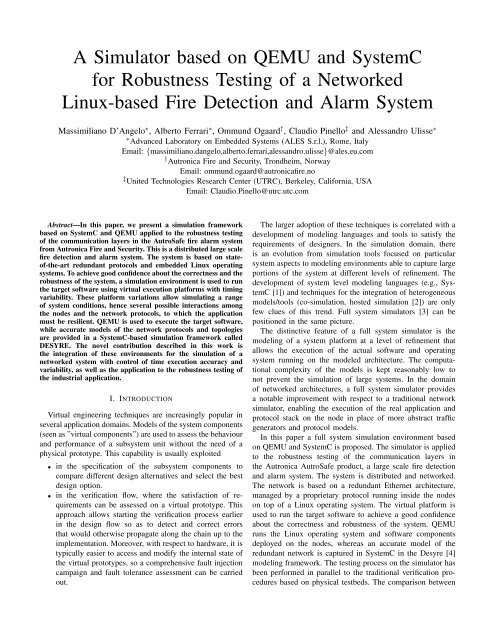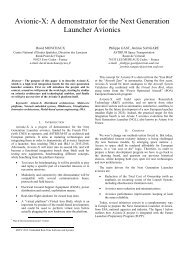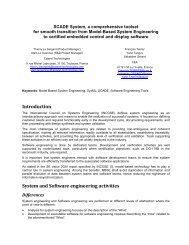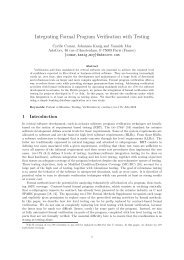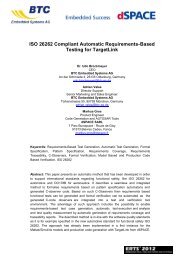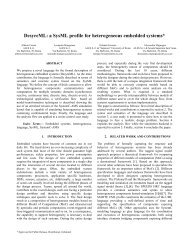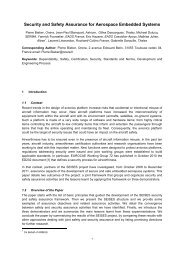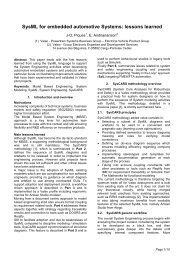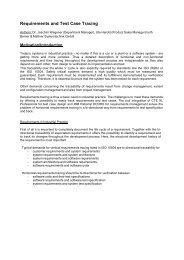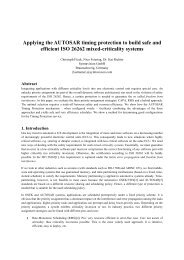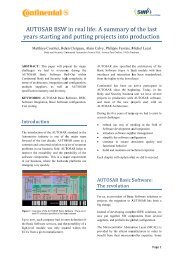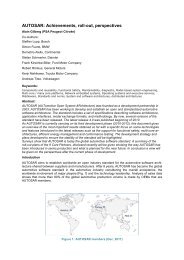A Simulator based on QEMU and SystemC for Robustness ... - SEE
A Simulator based on QEMU and SystemC for Robustness ... - SEE
A Simulator based on QEMU and SystemC for Robustness ... - SEE
You also want an ePaper? Increase the reach of your titles
YUMPU automatically turns print PDFs into web optimized ePapers that Google loves.
A <str<strong>on</strong>g>Simulator</str<strong>on</strong>g> <str<strong>on</strong>g>based</str<strong>on</strong>g> <strong>on</strong> <strong>QEMU</strong> <strong>and</strong> <strong>SystemC</strong><br />
<strong>for</strong> <strong>Robustness</strong> Testing of a Networked<br />
Linux-<str<strong>on</strong>g>based</str<strong>on</strong>g> Fire Detecti<strong>on</strong> <strong>and</strong> Alarm System<br />
Massimiliano D’Angelo ∗ , Alberto Ferrari ∗ , Ommund Ogaard † , Claudio Pinello ‡ <strong>and</strong> Aless<strong>and</strong>ro Ulisse ∗<br />
∗ Advanced Laboratory <strong>on</strong> Embedded Systems (ALES S.r.l.), Rome, Italy<br />
Email: {massimiliano.dangelo,alberto.ferrari,aless<strong>and</strong>ro.ulisse}@ales.eu.com<br />
† Autr<strong>on</strong>ica Fire <strong>and</strong> Security, Tr<strong>on</strong>dheim, Norway<br />
Email: ommund.ogaard@autr<strong>on</strong>icafire.no<br />
‡ United Technologies Research Center (UTRC), Berkeley, Cali<strong>for</strong>nia, USA<br />
Email: Claudio.Pinello@utrc.utc.com<br />
Abstract—In this paper, we present a simulati<strong>on</strong> framework<br />
<str<strong>on</strong>g>based</str<strong>on</strong>g> <strong>on</strong> <strong>SystemC</strong> <strong>and</strong> <strong>QEMU</strong> applied to the robustness testing<br />
of the communicati<strong>on</strong> layers in the AutroSafe fire alarm system<br />
from Autr<strong>on</strong>ica Fire <strong>and</strong> Security. This is a distributed large scale<br />
fire detecti<strong>on</strong> <strong>and</strong> alarm system. The system is <str<strong>on</strong>g>based</str<strong>on</strong>g> <strong>on</strong> stateof-the-art<br />
redundant protocols <strong>and</strong> embedded Linux operating<br />
systems. To achieve good c<strong>on</strong>fidence about the correctness <strong>and</strong> the<br />
robustness of the system, a simulati<strong>on</strong> envir<strong>on</strong>ment is used to run<br />
the target software using virtual executi<strong>on</strong> plat<strong>for</strong>ms with timing<br />
variability. These plat<strong>for</strong>m variati<strong>on</strong>s allow simulating a range<br />
of system c<strong>on</strong>diti<strong>on</strong>s, hence several possible interacti<strong>on</strong>s am<strong>on</strong>g<br />
the nodes <strong>and</strong> the network protocols, to which the applicati<strong>on</strong><br />
must be resilient. <strong>QEMU</strong> is used to execute the target software,<br />
while accurate models of the network protocols <strong>and</strong> topologies<br />
are provided in a <strong>SystemC</strong>-<str<strong>on</strong>g>based</str<strong>on</strong>g> simulati<strong>on</strong> framework called<br />
DESYRE. The novel c<strong>on</strong>tributi<strong>on</strong> described in this work is<br />
the integrati<strong>on</strong> of these envir<strong>on</strong>ments <strong>for</strong> the simulati<strong>on</strong> of a<br />
networked system with c<strong>on</strong>trol of time executi<strong>on</strong> accuracy <strong>and</strong><br />
variability, as well as the applicati<strong>on</strong> to the robustness testing of<br />
the industrial applicati<strong>on</strong>.<br />
I. INTRODUCTION<br />
Virtual engineering techniques are increasingly popular in<br />
several applicati<strong>on</strong> domains. Models of the system comp<strong>on</strong>ents<br />
(seen as ”virtual comp<strong>on</strong>ents”) are used to assess the behaviour<br />
<strong>and</strong> per<strong>for</strong>mance of a subsystem unit without the need of a<br />
physical prototype. This capability is usually exploited<br />
• in the specificati<strong>on</strong> of the subsystem comp<strong>on</strong>ents to<br />
compare different design alternatives <strong>and</strong> select the best<br />
design opti<strong>on</strong>.<br />
• in the verificati<strong>on</strong> flow, where the satisfacti<strong>on</strong> of requirements<br />
can be assessed <strong>on</strong> a virtual prototype. This<br />
approach allows starting the verificati<strong>on</strong> process earlier<br />
in the design flow so as to detect <strong>and</strong> correct errors<br />
that would otherwise propagate al<strong>on</strong>g the chain up to the<br />
implementati<strong>on</strong>. Moreover, with respect to hardware, it is<br />
typically easier to access <strong>and</strong> modify the internal state of<br />
the virtual prototypes, so a comprehensive fault injecti<strong>on</strong><br />
campaign <strong>and</strong> fault tolerance assessment can be carried<br />
out.<br />
The larger adopti<strong>on</strong> of these techniques is correlated with a<br />
development of modeling languages <strong>and</strong> tools to satisfy the<br />
requirements of designers. In the simulati<strong>on</strong> domain, there<br />
is an evoluti<strong>on</strong> from simulati<strong>on</strong> tools focused <strong>on</strong> particular<br />
system aspects to modeling envir<strong>on</strong>ments able to capture large<br />
porti<strong>on</strong>s of the system at different levels of refinement. The<br />
development of system level modeling languages (e.g., <strong>SystemC</strong><br />
[1]) <strong>and</strong> techniques <strong>for</strong> the integrati<strong>on</strong> of heterogeneous<br />
models/tools (co-simulati<strong>on</strong>, hosted simulati<strong>on</strong> [2]) are <strong>on</strong>ly<br />
few clues of this trend. Full system simulators [3] can be<br />
positi<strong>on</strong>ed in the same picture.<br />
The distinctive feature of a full system simulator is the<br />
modeling of a system plat<strong>for</strong>m at a level of refinement that<br />
allows the executi<strong>on</strong> of the actual software <strong>and</strong> operating<br />
system running <strong>on</strong> the modeled architecture. The computati<strong>on</strong>al<br />
complexity of the models is kept reas<strong>on</strong>ably low to<br />
not prevent the simulati<strong>on</strong> of large systems. In the domain<br />
of networked architectures, a full system simulator provides<br />
a notable improvement with respect to a traditi<strong>on</strong>al network<br />
simulator, enabling the executi<strong>on</strong> of the real applicati<strong>on</strong> <strong>and</strong><br />
protocol stack <strong>on</strong> the node in place of more abstract traffic<br />
generators <strong>and</strong> protocol models.<br />
In this paper a full system simulati<strong>on</strong> envir<strong>on</strong>ment <str<strong>on</strong>g>based</str<strong>on</strong>g><br />
<strong>on</strong> <strong>QEMU</strong> <strong>and</strong> <strong>SystemC</strong> is proposed. The simulator is applied<br />
to the robustness testing of the communicati<strong>on</strong> layers in<br />
the Autr<strong>on</strong>ica AutroSafe product, a large scale fire detecti<strong>on</strong><br />
<strong>and</strong> alarm system. The system is distributed <strong>and</strong> networked.<br />
The network is <str<strong>on</strong>g>based</str<strong>on</strong>g> <strong>on</strong> a redundant Ethernet architecture,<br />
managed by a proprietary protocol running inside the nodes<br />
<strong>on</strong> top of a Linux operating system. The virtual plat<strong>for</strong>m is<br />
used to run the target software to achieve a good c<strong>on</strong>fidence<br />
about the correctness <strong>and</strong> robustness of the system. <strong>QEMU</strong><br />
runs the Linux operating system <strong>and</strong> software comp<strong>on</strong>ents<br />
deployed <strong>on</strong> the nodes, whereas an accurate model of the<br />
redundant network is captured in <strong>SystemC</strong> in the Desyre [4]<br />
modeling framework. The testing process <strong>on</strong> the simulator has<br />
been per<strong>for</strong>med in parallel to the traditi<strong>on</strong>al verificati<strong>on</strong> procedures<br />
<str<strong>on</strong>g>based</str<strong>on</strong>g> <strong>on</strong> physical testbeds. The comparis<strong>on</strong> between
virtual <strong>and</strong> physical testing envir<strong>on</strong>ments has highlighted both<br />
benefits <strong>and</strong> limitati<strong>on</strong>s of the proposed simulati<strong>on</strong> plat<strong>for</strong>m.<br />
This paper is structured as follows. Secti<strong>on</strong> II summarizes<br />
the related c<strong>on</strong>tributi<strong>on</strong>s in literature <strong>and</strong> highlights the distinctive<br />
elements of the work. Secti<strong>on</strong> III describes the industrial<br />
case study, whereas the simulator envir<strong>on</strong>ment is depicted<br />
in secti<strong>on</strong> IV. The AutroSafe system model is described in<br />
Secti<strong>on</strong> V, together with numerical results to characterize<br />
the model accuracy <strong>and</strong> simulati<strong>on</strong> times. Secti<strong>on</strong> VI details<br />
how the simulator has been used <strong>for</strong> robustness testing of<br />
the AutroSafe system, <strong>and</strong> compares its capabilities with<br />
traditi<strong>on</strong>al physical testbeds.<br />
II. RELATED WORKS AND CONTRIBUTION<br />
Simulati<strong>on</strong> technologies that can support the full system<br />
simulati<strong>on</strong> of networked embedded systems are already available.<br />
Wind River Simics [5] is a commercial product with<br />
promising features in terms of modeling <strong>and</strong> support <strong>for</strong><br />
analysis. System models can be defined in different languages,<br />
am<strong>on</strong>g which <strong>SystemC</strong> TLM2.0, <strong>and</strong> can leverage a rich<br />
library of CPU architecture emulators. The Open Virtual Plat<strong>for</strong>m<br />
(OVP) [6] provides models of CPUs which can execute<br />
binaries, together with other comp<strong>on</strong>ents like memories <strong>and</strong><br />
buses, which allow the descripti<strong>on</strong> of a computati<strong>on</strong>al architecture.<br />
OVP models can be integrated with external simulators<br />
or imported in a <strong>SystemC</strong> TLM2.0 modeling envir<strong>on</strong>ment.<br />
Other soluti<strong>on</strong>s <strong>for</strong> full system simulati<strong>on</strong> include M5 [7] <strong>and</strong><br />
UNISIM [8], but they are at a less mature stage.<br />
<str<strong>on</strong>g>Simulator</str<strong>on</strong>g>s <str<strong>on</strong>g>based</str<strong>on</strong>g> <strong>on</strong> the integrati<strong>on</strong> of <strong>QEMU</strong> with <strong>SystemC</strong><br />
have been proposed in literature. <strong>QEMU</strong> provides an opensource<br />
emulati<strong>on</strong> plat<strong>for</strong>m, which can be modified to fit into<br />
the modeling framework <strong>and</strong> enhanced to suit the modeling<br />
requirements. The executi<strong>on</strong> of the target code is <str<strong>on</strong>g>based</str<strong>on</strong>g> <strong>on</strong><br />
dynamic translati<strong>on</strong> <strong>and</strong> is hence faster than traditi<strong>on</strong>al instructi<strong>on</strong><br />
set simulators. This enables the executi<strong>on</strong> of operating<br />
systems <strong>and</strong> large applicati<strong>on</strong> processes, as well as the descripti<strong>on</strong><br />
of models with several instances of <strong>QEMU</strong>, without<br />
incurring in prohibitive slow down of the simulati<strong>on</strong>. In [9],<br />
the PCI/AMBA bus in <strong>QEMU</strong> is interfaced with <strong>SystemC</strong><br />
to model hardware peripherals. The interacti<strong>on</strong> between the<br />
modeling envir<strong>on</strong>ments is <str<strong>on</strong>g>based</str<strong>on</strong>g> <strong>on</strong> synchr<strong>on</strong>ous transacti<strong>on</strong>s,<br />
initiated by <strong>QEMU</strong>. <strong>QEMU</strong> is frozen while the <strong>SystemC</strong><br />
simulati<strong>on</strong> per<strong>for</strong>ms the transacti<strong>on</strong>. A similar approach is proposed<br />
in [10] to integrate a GPU model with <strong>QEMU</strong>. A more<br />
refined integrati<strong>on</strong> between <strong>QEMU</strong> <strong>and</strong> a <strong>SystemC</strong> model of<br />
a peripheral is proposed in [11], where the communicati<strong>on</strong><br />
with the external module is transparent to the peripheral driver<br />
running in the virtual machine. In [12], <strong>QEMU</strong> <strong>and</strong> <strong>SystemC</strong><br />
are combined to implement a fast cycle-accurate instructi<strong>on</strong> set<br />
simulator. The instructi<strong>on</strong>s executed in <strong>QEMU</strong> are simulated at<br />
the cycle accurate level in <strong>SystemC</strong>. <strong>QEMU</strong> sends to <strong>SystemC</strong><br />
all the in<strong>for</strong>mati<strong>on</strong> (instructi<strong>on</strong> types, register values, memory<br />
accesses) about the instructi<strong>on</strong>s to be executed.<br />
A possible approach to use <strong>QEMU</strong> <strong>for</strong> networked system<br />
modeling is to resort to the Virtual Distributed Ethernet (VDE)<br />
project [13], which provides models to build a virtual ethernet<br />
network am<strong>on</strong>g the virtual machines. The network is interfaced<br />
with <strong>QEMU</strong> using native capabilities of the virtual machine.<br />
The models enable the exchange of network frames am<strong>on</strong>g<br />
the machines, but capture the behaviour of the network at a<br />
very abstract level, with little or no noti<strong>on</strong> of time.<br />
The original c<strong>on</strong>tributi<strong>on</strong> of this paper is twofold:<br />
• A simulator <str<strong>on</strong>g>based</str<strong>on</strong>g> <strong>on</strong> <strong>SystemC</strong> <strong>and</strong> <strong>QEMU</strong> is proposed.<br />
Differently from the works available in literature, the<br />
simulator addresses a networked system, in which several<br />
<strong>QEMU</strong> instances are coordinated by the <strong>SystemC</strong><br />
scheduler. Both the <strong>QEMU</strong> <strong>and</strong> <strong>SystemC</strong> comp<strong>on</strong>ents can<br />
generate events in their internal time representati<strong>on</strong>, <strong>and</strong><br />
a suitable approach is needed to mantain a chr<strong>on</strong>ological<br />
relati<strong>on</strong>ship am<strong>on</strong>g these events.<br />
• An applicati<strong>on</strong> of the simulator <strong>for</strong> robustness testing<br />
of a state of the art fire detecti<strong>on</strong> <strong>and</strong> alarm system is<br />
described. The usage of the simulator in an industrial<br />
c<strong>on</strong>text allows exercising the simulator capabilities to a<br />
larger extent than with ad-hoc case studies. The analysis<br />
of the verificati<strong>on</strong> process of a safety critical system<br />
points out the role, the benefits <strong>and</strong> the limitati<strong>on</strong>s of<br />
a virtual engineering plat<strong>for</strong>m with respect to traditi<strong>on</strong>al<br />
physical testbeds.<br />
III. INDUSTRIAL APPLICATION: DETECTION AND ALARM<br />
SYSTEM<br />
The AutroSafe [14] product family is the high-end fire detecti<strong>on</strong><br />
system in the Autr<strong>on</strong>ica Fire <strong>and</strong> Security [15] product<br />
portfolio. It targets the <strong>on</strong>-shore market (buildings, industrial<br />
facilities), the maritime market (ships) <strong>and</strong> the petrochemical<br />
oil&gas market. Similarly to other fire detecti<strong>on</strong> systems, an<br />
AutroSafe installati<strong>on</strong> is composed of a set of C<strong>on</strong>trol <strong>and</strong><br />
Indicating Equipments (CIE). A CIE is resp<strong>on</strong>sible <strong>for</strong> c<strong>on</strong>trolling<br />
a particular area of the installati<strong>on</strong> plant. It manages<br />
the inputs received by a set of near-by detecti<strong>on</strong> devices (e.g.,<br />
smoke detectors) <strong>and</strong> may trigger the activati<strong>on</strong> of alarm <strong>and</strong><br />
protecti<strong>on</strong> devices (e.g., strobes, sounders, fire doors, fans).<br />
Moreover, a CIE may have a user interface (LCD screen <strong>and</strong><br />
keyboard) to show the status of the system <strong>and</strong> to get inputs<br />
from a fire security operator (e.g., reset an alarm, modify the<br />
system c<strong>on</strong>figurati<strong>on</strong>).<br />
CIEs communicate with each other to share their local status<br />
<strong>and</strong> coordinate their acti<strong>on</strong>s in the event of a fire. A fire<br />
detecti<strong>on</strong> in a particular area of a building, <strong>for</strong> instance, may<br />
require the activati<strong>on</strong> of alarm devices all over the building,<br />
possibly in a phased order. In the AutroSafe versi<strong>on</strong> that was<br />
tested, the interc<strong>on</strong>necti<strong>on</strong> am<strong>on</strong>g the CIEs is guaranteed by a<br />
redundant ethernet network, where all the network comp<strong>on</strong>ents<br />
are duplicated to achieve tolerance to faults. The redundant<br />
c<strong>on</strong>necti<strong>on</strong> is managed by a proprietary protocol, AutroNet.<br />
This network architecture is <strong>on</strong>e of the most relevant novelties<br />
introduced in this system.<br />
The functi<strong>on</strong>alities to per<strong>for</strong>m detecti<strong>on</strong>, alarm <strong>and</strong> protecti<strong>on</strong><br />
functi<strong>on</strong>alities, as well as the AutroNet protocol, are all<br />
implemented by software comp<strong>on</strong>ents running inside a CIE <strong>on</strong><br />
top of a Linux operating system. In terms of computati<strong>on</strong>al
capabilities, each CIE has an Atmel AVR32 microc<strong>on</strong>troller<br />
as main computati<strong>on</strong>al unit.<br />
In the design process of a new fire detecti<strong>on</strong> <strong>and</strong> alarm<br />
system, the testing of the software comp<strong>on</strong>ents takes a large<br />
percentage of time <strong>on</strong> the overall project durati<strong>on</strong>. Errors in<br />
the software implementati<strong>on</strong> might compromise the system<br />
functi<strong>on</strong>alities <strong>and</strong> its reliability, <strong>and</strong> would be costly to be<br />
fixed when several installati<strong>on</strong>s have been already put in place.<br />
In Autr<strong>on</strong>ica, the testing procedure involves several steps <strong>and</strong><br />
is per<strong>for</strong>med <strong>on</strong> different testing infrastructures. Testing in the<br />
early development stage is per<strong>for</strong>med running the software<br />
comp<strong>on</strong>ents <strong>on</strong> a st<strong>and</strong>ard Linux PC, used as an emulator of<br />
a st<strong>and</strong>-al<strong>on</strong>e CIE. It provides a c<strong>on</strong>venient testbed <strong>for</strong> the<br />
developers to verify their implementati<strong>on</strong> <strong>on</strong> the same machine<br />
where the comp<strong>on</strong>ents are being developed. Nevertheless,<br />
testing is limited at this stage to functi<strong>on</strong>alities which can<br />
be exercised <strong>on</strong> an isolated node, <strong>and</strong> may require some<br />
modificati<strong>on</strong> of the original code to remove any dependency<br />
from particular features of the actual hardware plat<strong>for</strong>m.<br />
A more refined testing infrastructure is composed of a set<br />
of test boards, c<strong>on</strong>nected by an Ethernet network. Compared<br />
to the actual CIE, each test board has a microc<strong>on</strong>troller<br />
with the same instructi<strong>on</strong> set architecture, different board<br />
characteristics <strong>and</strong> lower overall per<strong>for</strong>mance. Moreover, each<br />
board provides two ethernet network interfaces to setup the<br />
redundant c<strong>on</strong>necti<strong>on</strong>. This testbed can properly exercise all<br />
the software comp<strong>on</strong>ents which exchange data <strong>on</strong> the inter-<br />
CIE link, as well as the AutroNet protocol which manages the<br />
network redundancy. In Autr<strong>on</strong>ica, engineers usually have a<br />
small scale testbed <strong>on</strong> their desks to per<strong>for</strong>m some preliminary<br />
testing over a networked system. In additi<strong>on</strong>, a single larger<br />
testbed with 64 boards is available <strong>for</strong> extensive tests.<br />
In the latest stage of the development process, testing is<br />
completed <strong>on</strong> an exact replica of a system installati<strong>on</strong>, where<br />
the test boards are replaced by the hardware of the actual<br />
CIE. A CIE provides the whole set of peripherals that must<br />
be managed by the software comp<strong>on</strong>ents, which can hence be<br />
fully executed without the need <strong>for</strong> stubs.<br />
<strong>Robustness</strong> testing<br />
<strong>Robustness</strong> is defined as the degree to which a system<br />
operates correctly in the presence of excepti<strong>on</strong>al inputs or<br />
stressful envir<strong>on</strong>mental c<strong>on</strong>diti<strong>on</strong>s [16]. Dependable systems<br />
must be proven to be robust.<br />
The key to robustness testing is to develop test cases <strong>and</strong><br />
test envir<strong>on</strong>ments where the robustness of a system can be<br />
assessed. Testing is usually focused <strong>on</strong> software comp<strong>on</strong>ents,<br />
which are more likely to fail when unintended c<strong>on</strong>diti<strong>on</strong>s<br />
occur. The test cases must cover st<strong>and</strong>ard <strong>and</strong> excepti<strong>on</strong>al,<br />
but legal, operating c<strong>on</strong>diti<strong>on</strong>s. The system must work when<br />
fed with intended <strong>and</strong> unintended inputs, in different operating<br />
scenarios <strong>and</strong> architectural c<strong>on</strong>figurati<strong>on</strong>s. Safety critical systems<br />
may also require a certain degree of robustness to fault<br />
c<strong>on</strong>diti<strong>on</strong>s.<br />
The verificati<strong>on</strong> process in Autr<strong>on</strong>ica includes an assessment<br />
of the system robustness. Test procedures describe sequences<br />
of operati<strong>on</strong>s to be per<strong>for</strong>med <strong>on</strong> the system, <strong>and</strong><br />
the expected status of the system after each operati<strong>on</strong>. The<br />
acti<strong>on</strong>s per<strong>for</strong>med include powering up the nodes in different<br />
sequences <strong>and</strong> with r<strong>and</strong>om delays, rebooting or shutting down<br />
a subset of the nodes, disc<strong>on</strong>necting some cables. Moreover,<br />
the system inputs are fed by hardware emulators of the CIE<br />
peripherals, which may generate critical sequences of data.<br />
The system model that will be described in the next secti<strong>on</strong>s<br />
complements the testing infrastructure of the AutroSafe system<br />
by providing the chance to alter to a larger extent the plat<strong>for</strong>m<br />
<strong>on</strong> which the AutroSafe software comp<strong>on</strong>ents are running. A<br />
model is <str<strong>on</strong>g>based</str<strong>on</strong>g> <strong>on</strong> an abstracti<strong>on</strong> of the system plat<strong>for</strong>m, <strong>and</strong><br />
mimics its behaviour up to a certain extent. While a good<br />
correlati<strong>on</strong> with the real system is desirable to positi<strong>on</strong> the<br />
model in the reference operating c<strong>on</strong>diti<strong>on</strong>, perturbati<strong>on</strong>s of<br />
the executi<strong>on</strong> flow, due to model approximati<strong>on</strong>s or injected<br />
intenti<strong>on</strong>ally allow testing the robustness of the system. A<br />
virtual testing plat<strong>for</strong>m provides more opportunities to introduce<br />
variability, <strong>and</strong> guarantees a higher observability with<br />
respect to a physical testbed. System architectures can be<br />
easily rec<strong>on</strong>figured in the virtual domain to capture alternative<br />
c<strong>on</strong>figurati<strong>on</strong>s; faults that are difficult to be injected in a<br />
physical system can be more easily introduced in the system<br />
model. The availability of probing facilities in the simulator<br />
allows inspecti<strong>on</strong> of the status of all the comp<strong>on</strong>ents in the<br />
system, <strong>and</strong> identificati<strong>on</strong> of unintended behaviours that might<br />
be latent <strong>on</strong> the physical testbed.<br />
IV. SIMULATION FRAMEWORK DESCRIPTION<br />
The simulator framework is built by integrating the <strong>QEMU</strong><br />
virtual machine with the Desyre simulati<strong>on</strong> framework.<br />
<strong>QEMU</strong> executes the operating system <strong>and</strong> the applicati<strong>on</strong><br />
processes running <strong>on</strong> a node of the system. Multiple instances<br />
of <strong>QEMU</strong> are interc<strong>on</strong>nected by a model of the network<br />
architecture captured in the <strong>SystemC</strong> language in the Desyre<br />
framework. The integrati<strong>on</strong> has required the definiti<strong>on</strong> of a<br />
specific interface between the two envir<strong>on</strong>ments, so as to<br />
enable data exchange <strong>and</strong> executi<strong>on</strong> coordinati<strong>on</strong>. In particular,<br />
the internal times in Desyre <strong>and</strong> <strong>QEMU</strong> are synchr<strong>on</strong>ized to<br />
maintain the correct chr<strong>on</strong>ological relati<strong>on</strong>ship between the<br />
events in the two different timing domains. More details will<br />
be provided in the following subsecti<strong>on</strong>s.<br />
A. <strong>QEMU</strong><br />
<strong>QEMU</strong> is an open-source machine emulator <strong>and</strong> virtualizer.<br />
It can emulate several instructi<strong>on</strong> set architectures; currenty,<br />
the set of emulated architectures c<strong>on</strong>tains x86, PowerPC,<br />
Sparc32/64, MIPS, ARM <strong>and</strong> Coldfire. Emulati<strong>on</strong> is <str<strong>on</strong>g>based</str<strong>on</strong>g><br />
<strong>on</strong> dynamic (run-time) translati<strong>on</strong> of basic blocks of the target<br />
CPU instructi<strong>on</strong>s into the host instructi<strong>on</strong> set. <strong>QEMU</strong> has two<br />
operating modes:<br />
• Full system emulati<strong>on</strong>. In this mode, <strong>QEMU</strong> emulates a<br />
full system, including a processor <strong>and</strong> various peripherals.<br />
A <strong>QEMU</strong> system plat<strong>for</strong>m can be used to execute<br />
different operating systems.
• User mode emulati<strong>on</strong>. In this mode, <strong>QEMU</strong> can launch<br />
processes (not OSes) compiled <strong>for</strong> <strong>on</strong>e CPU <strong>on</strong> another<br />
CPU, whereas compatibility is needed between the applicati<strong>on</strong><br />
<strong>and</strong> the hosting operating system where <strong>QEMU</strong> is<br />
running.<br />
To implement the full system emulati<strong>on</strong>, <strong>QEMU</strong> provides a set<br />
of predefined system plat<strong>for</strong>ms, characterized by a particular<br />
instructi<strong>on</strong> set architecture <strong>and</strong> by a set of emulated devices.<br />
The list of system plat<strong>for</strong>ms includes (but is not limited to) a<br />
PC system <str<strong>on</strong>g>based</str<strong>on</strong>g> <strong>on</strong> the x86 emulator, a PREP or PowerMac<br />
PowerPC system with a PowerPC cpu, a UltraSPARC machine<br />
<str<strong>on</strong>g>based</str<strong>on</strong>g> <strong>on</strong> sparc64, several boards <str<strong>on</strong>g>based</str<strong>on</strong>g> <strong>on</strong> ARM. The emulated<br />
devices available <strong>for</strong> each plat<strong>for</strong>m can be binded to host<br />
devices, redirected to files, or c<strong>on</strong>figured to be accessible from<br />
other processes in the host system, e.g., by sockets.<br />
B. Desyre<br />
The Desyre framework [4] is a <strong>SystemC</strong>-<str<strong>on</strong>g>based</str<strong>on</strong>g> virtual prototyping<br />
envir<strong>on</strong>ment. In this framework, the virtual prototype<br />
is composed of a set of modeling comp<strong>on</strong>ents, instantiated<br />
out of model libraries which may cover functi<strong>on</strong>al <strong>and</strong> architectural<br />
aspects of the system (e.g., protocol models, communicati<strong>on</strong><br />
channels, computati<strong>on</strong>al plat<strong>for</strong>ms). The virtual<br />
prototype is specified as a hierarchical netlist with a set of<br />
parameterized c<strong>on</strong>figurati<strong>on</strong> input files, compliant to the IP-<br />
XACT <strong>for</strong>mat [17]. These files define <strong>and</strong> instantiate the<br />
model comp<strong>on</strong>ents, <strong>and</strong> c<strong>on</strong>nect them together to specify the<br />
model of the entire system. To facilitate the generati<strong>on</strong> of the<br />
system netlists <strong>for</strong> complex designs <strong>and</strong> <strong>for</strong> the design space<br />
explorati<strong>on</strong>, Desyre provides an explorati<strong>on</strong> language (EL) to<br />
describe in a more c<strong>on</strong>cise <strong>for</strong>m, as parameter sets <strong>and</strong> parameter<br />
relati<strong>on</strong>s, the different c<strong>on</strong>figurati<strong>on</strong>s to be simulated.<br />
The EL specificati<strong>on</strong> is used to automatically generate <strong>and</strong><br />
parameterize the IP-XACT file sets, representing the selected<br />
scenarios. The designer has the freedom to run selectively<br />
the simulati<strong>on</strong> of a scenario or of all scenarios as a batch<br />
explorati<strong>on</strong>. A simulati<strong>on</strong> is per<strong>for</strong>med in three phases:<br />
1) Netlist elaborati<strong>on</strong> <strong>and</strong> comp<strong>on</strong>ent loading;<br />
2) Simulati<strong>on</strong>;<br />
3) Data post-processing <strong>and</strong> visualizati<strong>on</strong>.<br />
The first two phases are repeated <strong>for</strong> each of the chosen<br />
scenarios. In the elaborati<strong>on</strong> <strong>and</strong> loading phase, according<br />
to the designer’s netlists, the model builder of DESYRE<br />
dynamically creates in memory the system model by parsing<br />
the IP-XACT files <strong>and</strong> loading the required <strong>SystemC</strong> models<br />
(compiled <strong>and</strong> present in the library). In simulati<strong>on</strong>, the created<br />
system model is executed <strong>and</strong> the output traces are produced.<br />
In the data post-processing, traces are analyzed to aggregate<br />
<strong>and</strong>/or verify the per<strong>for</strong>mance <strong>and</strong> the functi<strong>on</strong>al data.<br />
The dynamic technique <strong>for</strong> the model creati<strong>on</strong> facilitates<br />
the design space explorati<strong>on</strong> by 1) removing the need <strong>for</strong><br />
the compilati<strong>on</strong> of the different <strong>SystemC</strong> netlists (the flow<br />
is compiler free); 2) enabling the designer to quickly derive<br />
additi<strong>on</strong>al scenarios by parameterizing the EL or IP-XACT<br />
files.<br />
DESYRE<br />
Fig. 1.<br />
<strong>QEMU</strong><br />
nic1<br />
netif IP<br />
(1)<br />
...<br />
Process<br />
instantiati<strong>on</strong><br />
nicN<br />
Exec<br />
loop<br />
ttyS0<br />
... netif IP<br />
qemu IP<br />
(N)<br />
Network model<br />
adapter<br />
Interface between <strong>QEMU</strong> <strong>and</strong> Desyre<br />
C. Architecture of the Desyre - <strong>QEMU</strong> integrati<strong>on</strong><br />
Desyre <strong>and</strong> the <strong>QEMU</strong> instances run as distinct processes<br />
<strong>on</strong> a Linux host system. <strong>QEMU</strong> is c<strong>on</strong>figured in full system<br />
emulati<strong>on</strong> mode, with a parametrized number of network<br />
interfaces <strong>and</strong> a serial port. The creati<strong>on</strong> of the multi-process<br />
envir<strong>on</strong>ment is managed through Desyre, <strong>and</strong> is <str<strong>on</strong>g>based</str<strong>on</strong>g> <strong>on</strong> a<br />
descripti<strong>on</strong> of the system model in the IP-XACT metamodel.<br />
The interacti<strong>on</strong> with an external <strong>QEMU</strong> process is managed<br />
by an adapter (Figure 1), composed of the following Desyre<br />
modules:<br />
• A qemu IP, which is resp<strong>on</strong>sible <strong>for</strong> instantiating a<br />
<strong>QEMU</strong> process at the simulati<strong>on</strong> start-up. During the<br />
simulati<strong>on</strong>, the module schedules the executi<strong>on</strong> of the<br />
<strong>QEMU</strong> instance <strong>and</strong> keeps the internal time of <strong>QEMU</strong><br />
synchr<strong>on</strong>ized with the Desyre time. The module may also<br />
issue the executi<strong>on</strong> of a comm<strong>and</strong> at a particular time in<br />
the c<strong>on</strong>sole of the guest operating system, accessed by<br />
the emulated serial port (ttyS0 in Figure 1) c<strong>on</strong>nected<br />
to a socket. At the end of the simulati<strong>on</strong>, it per<strong>for</strong>ms<br />
the shutdown of the virtual machine <strong>and</strong> collects the<br />
(eventual) logs generated inside the virtual machine <strong>and</strong><br />
stored <strong>on</strong> the virtual disk. The c<strong>on</strong>figurati<strong>on</strong> of <strong>QEMU</strong><br />
(parameter values <strong>and</strong> emulated devices to be instantiated)<br />
is captured in the IP-XACT files, as parameters of<br />
the <strong>QEMU</strong> IP.<br />
• A netif IP, which acts as an adapter between the emulated<br />
network interface card in <strong>QEMU</strong> <strong>and</strong> the model of the<br />
network in Desyre.<br />
Notice that the partiti<strong>on</strong>ing of the functi<strong>on</strong>alities in two<br />
different modules keeps the <strong>QEMU</strong> IP orthog<strong>on</strong>al from the<br />
particular model being interfaced with <strong>QEMU</strong>, <strong>and</strong> permits<br />
reusing this IP when different or additi<strong>on</strong>al parts of the systems<br />
(e.g., node peripherals) will be captured in Desyre.
The integrati<strong>on</strong> has required several modificati<strong>on</strong>s of the<br />
<strong>QEMU</strong> source code. The flow of executi<strong>on</strong> of the target<br />
instructi<strong>on</strong>s has been modified to enable its suspensi<strong>on</strong> <strong>and</strong><br />
resuming. More in detail, the virtual machine can be executed<br />
<strong>for</strong> an amount of virtual time ∆T be<strong>for</strong>e suspending: say t<br />
the internal time of the machine when executi<strong>on</strong> is granted<br />
<strong>for</strong> ∆T time, the machine will suspend when its internal time<br />
will be t + ∆T . The c<strong>on</strong>trol of the executi<strong>on</strong> flow is exposed<br />
by <strong>QEMU</strong> <strong>on</strong> a unix socket (exec loop in Figure 1) to which<br />
a <strong>QEMU</strong> IP is c<strong>on</strong>nected.<br />
The emulated network card in <strong>QEMU</strong> can be natively<br />
redirected to a socket, where network frames can be exchanged<br />
with an external process. This mechanism is exploited, <strong>for</strong><br />
instance, by VDE. However, the transmissi<strong>on</strong> of a frame in<br />
<strong>QEMU</strong> is modeled at a purely functi<strong>on</strong>al level, with no noti<strong>on</strong><br />
of time. Modificati<strong>on</strong>s have been introduced in the emulated<br />
card to expose the transmissi<strong>on</strong> delays assessed in the Desyre<br />
model to the virtual machine. In the modified <strong>QEMU</strong>, a<br />
delay is introduced in the virtual machine time between the<br />
request of a transmissi<strong>on</strong> <strong>and</strong> the interrupt which signals to the<br />
emulated CPU that the frame has been actually transmitted.<br />
The amount of time required <strong>for</strong> the transmissi<strong>on</strong> is assessed<br />
by Desyre <strong>and</strong> is notified to the virtual machine. Besides the<br />
transmissi<strong>on</strong> <strong>and</strong> recepti<strong>on</strong> of frames, the interacti<strong>on</strong> between<br />
the emulated NIC <strong>and</strong> the Desyre model has been enhanced to<br />
synchr<strong>on</strong>ize the status <strong>and</strong> c<strong>on</strong>figurati<strong>on</strong> of the cards (e.g., <strong>for</strong><br />
an Ethernet network card, power <strong>on</strong>/power off state, promiscuous<br />
mode enabled/disabled, link state, multicast masks). The<br />
exchange of in<strong>for</strong>mati<strong>on</strong> is managed <strong>on</strong> the Desyre side by<br />
the netif IP, <strong>and</strong> is per<strong>for</strong>med through a UNIX socket (nic1 to<br />
nicN in Figure 1). All the messages exchanged <strong>on</strong> the socket<br />
are tagged with a timestamp in the sender time.<br />
The architecture of the simulator facilitates distributi<strong>on</strong> of<br />
the processes involved in the simulati<strong>on</strong> <strong>on</strong> a set of interc<strong>on</strong>nected<br />
hosting machines, so as to build a distributed simulati<strong>on</strong><br />
plat<strong>for</strong>m. Communicati<strong>on</strong> am<strong>on</strong>g the simulati<strong>on</strong> processes<br />
over the network may lead to l<strong>on</strong>ger simulati<strong>on</strong> times. Techniques<br />
to mitigate per<strong>for</strong>mance penalties <strong>and</strong> enable largescale<br />
highly-distributed simulati<strong>on</strong>s are under investigati<strong>on</strong> by<br />
the authors in the c<strong>on</strong>text of the SPRINT EU project [18]. The<br />
first results <strong>on</strong> synchr<strong>on</strong>izati<strong>on</strong> algorithms have been injected<br />
in the current versi<strong>on</strong> of the simulator, so as to allow the user<br />
to select the best trade-off between synchr<strong>on</strong>izati<strong>on</strong> overhead<br />
<strong>and</strong> accuracy.<br />
D. Time synchr<strong>on</strong>izati<strong>on</strong><br />
The executi<strong>on</strong> of each <strong>QEMU</strong> instance is c<strong>on</strong>trolled by<br />
Desyre to make time progress in the two envir<strong>on</strong>ments in a<br />
c<strong>on</strong>sistent way. Two different approaches have been implemented<br />
in the <strong>QEMU</strong> IP to schedule the executi<strong>on</strong> of the<br />
virtual machine:<br />
• Fixed step executi<strong>on</strong>. At time t i , each <strong>QEMU</strong> instance<br />
is scheduled <strong>for</strong> executi<strong>on</strong> <strong>for</strong> a fixed amount of time<br />
∆T f . When all the <strong>QEMU</strong> instances have reached time<br />
t i + ∆T f , Desyre advances its time up to time t i + ∆T f .<br />
At this point, a new scheduling round is started.<br />
<strong>QEMU</strong><br />
Desyre<br />
ΔT<br />
E S<br />
Fig. 2. Events generated by Desyre are scheduled at the beginning of the<br />
next scheduling slot in <strong>QEMU</strong><br />
• Variable step executi<strong>on</strong>. At time t i , the Desyre simulator<br />
retrieves the time of the next internal event t i+1 .<br />
<strong>QEMU</strong> is scheduled <strong>for</strong> executi<strong>on</strong> <strong>for</strong> an amount of time<br />
∆T v = t i+1 − t i . When all the <strong>QEMU</strong> instances have<br />
reached time t i+1 , Desyre advances its time up to t i+1<br />
(i.e., process the next event). The user can specify an<br />
upper <strong>and</strong> lower bound <strong>for</strong> ∆T v : the upper bound avoids<br />
that the virtual machine <strong>and</strong> Desyre get largely out of<br />
synchr<strong>on</strong>izati<strong>on</strong>; the lower bound prevents an excessive<br />
slow-down of the simulati<strong>on</strong>.<br />
The scheduling algorithm to be used can be selected by the<br />
simulator user.<br />
Notice that in both scheduling algorithms, <strong>QEMU</strong> gets<br />
ahead in time with respect to Desyre. When <strong>QEMU</strong> passes<br />
a message to Desyre (e.g., a packet transmissi<strong>on</strong>), Desyre can<br />
properly schedule the processing of the message, because the<br />
message has been generated in the future with respect to its<br />
internal time. A message flowing <strong>on</strong> the other way will have<br />
a timestamp in the past with respect to the <strong>QEMU</strong> time, <strong>and</strong><br />
will be processed at the beginning of the next scheduling slot<br />
(Figure 2). This process introduces an approximati<strong>on</strong> (E s ) in<br />
the scheduling of the events (synchr<strong>on</strong>izati<strong>on</strong> approximati<strong>on</strong>),<br />
which can be reduced by using a smaller scheduling step<br />
(∆T ). The variable step soluti<strong>on</strong>, by adapting the value of<br />
∆T to the time of the Desyre events, aims at stopping the<br />
virtual machine at the time instant when a message might be<br />
notified by Desyre to <strong>QEMU</strong> (the notificati<strong>on</strong> of a message<br />
is an event in Desyre). A numerical comparis<strong>on</strong> of the two<br />
scheduling policies is provided in Secti<strong>on</strong> V-B.<br />
V. SYSTEM MODEL<br />
The architecture of the system model is depicted in Figure 3.<br />
A set of <strong>QEMU</strong> instances model the CIEs in the AutroSafe<br />
system. Since <strong>QEMU</strong> does not currently support the emulati<strong>on</strong><br />
of the AVR32 architecture, a x86 architecture emulator is<br />
used. The applicati<strong>on</strong> processes of the AutroSafe system must<br />
hence be compiled <strong>for</strong> the x86 architecture to be executed<br />
<strong>on</strong> the simulator. These processes run in <strong>QEMU</strong> <strong>on</strong> top of<br />
a Linux operating system. The set of AutroSafe processes<br />
ported <strong>on</strong> the simulator includes the proprietary protocol,<br />
AutroNet, which manages the redundant c<strong>on</strong>necti<strong>on</strong>. Each
CIE 1<br />
AutroSafe<br />
+<br />
Linux OS<br />
<strong>QEMU</strong><br />
CIE 2<br />
AutroSafe<br />
+<br />
Linux OS<br />
<strong>QEMU</strong><br />
Redundant Ethernet network model<br />
...<br />
CIE N<br />
AutroSafe<br />
+<br />
Linux OS<br />
<strong>QEMU</strong><br />
Adapter Adapter Adapter<br />
Fig. 3.<br />
Architecture of the AutroSafe system model<br />
DESYRE<br />
<strong>QEMU</strong> is c<strong>on</strong>figured to have two ethernet network interfaces.<br />
Some peripherals of the CIE are currently not captured by<br />
<strong>QEMU</strong> (e.g., interface <strong>for</strong> the loop of detectors <strong>and</strong> alarm<br />
devices). Desyre is exploited to build a model of a redundant<br />
ethernet network. The library of Ethernet network comp<strong>on</strong>ents<br />
in Desyre has been defined <str<strong>on</strong>g>based</str<strong>on</strong>g> <strong>on</strong> the IEEE802.3 st<strong>and</strong>ard,<br />
<strong>and</strong> covers both the MAC <strong>and</strong> PHY layers of the protocol. The<br />
models are defined at the TLM level of abstracti<strong>on</strong>, <strong>and</strong> allow<br />
the simulator to achieve an accurate estimati<strong>on</strong> of the most<br />
relevant network metrics, like latency, throughput <strong>and</strong> queue<br />
lengths.<br />
An Ethernet frame flowing out of the network interface<br />
card of <strong>QEMU</strong> is injected through the adapter in the Ethernet<br />
network model, propagates through the network <strong>and</strong> is then<br />
passed to the <strong>QEMU</strong> virtual machine modeling the intended<br />
recipient.<br />
A. Time model <strong>for</strong> software executi<strong>on</strong><br />
The speed of executi<strong>on</strong> in <strong>QEMU</strong> has been adjusted to<br />
roughly mimic the computati<strong>on</strong>al per<strong>for</strong>mance of the actual<br />
target plat<strong>for</strong>m. <strong>QEMU</strong> natively provides a parameter (icount)<br />
<strong>for</strong> specifying the amount of virtual time (in ns) that each<br />
instructi<strong>on</strong> requires to be executed. Notice that the inverse<br />
of the icount gives the number of instructi<strong>on</strong>s per sec<strong>on</strong>d<br />
(IPS) that the virtual machine can execute. When the icount<br />
parameter is set, the progress of the virtual time is correlated<br />
with the executi<strong>on</strong> of the instructi<strong>on</strong>s.<br />
The icount parameter has been calibrated to achieve the<br />
best correlati<strong>on</strong> with the AVR32 CPU <strong>on</strong> the target. The<br />
CoreMark benchmark has been executed <strong>on</strong> the test board to<br />
get a reference value; then, the benchmark has been executed<br />
<strong>on</strong> <strong>QEMU</strong> to tune the icount value. The native icount value<br />
in <strong>QEMU</strong> is c<strong>on</strong>strained to be a power of 2; to achieve a<br />
better resoluti<strong>on</strong>, <strong>QEMU</strong> has been modified to work with<br />
integer icount values. A time <strong>for</strong> instructi<strong>on</strong> of 17 ns yields<br />
the benchmark score closest to the result <strong>on</strong> the test board.<br />
Secti<strong>on</strong> V-B will provide a comparis<strong>on</strong> of the estimated<br />
executi<strong>on</strong> times of the AutroNet process <strong>on</strong> the ”calibrated”<br />
<strong>QEMU</strong> with the measurements taken <strong>on</strong> the test board. Note<br />
that this calibrati<strong>on</strong> does not depend <strong>on</strong> the per<strong>for</strong>mance of<br />
the host but rather <strong>on</strong> the per<strong>for</strong>mance of the emulated (x86)<br />
plat<strong>for</strong>m.<br />
B. Accuracy & per<strong>for</strong>mance assessment<br />
The simulator has been exercised to characterize its correlati<strong>on</strong><br />
with the physical testbed <strong>and</strong> its per<strong>for</strong>mance in terms of<br />
ratio between simulati<strong>on</strong> <strong>and</strong> simulated time. A system with<br />
two CIEs interc<strong>on</strong>nected by a redundant network has been<br />
c<strong>on</strong>sidered <strong>for</strong> comparis<strong>on</strong> between the physical <strong>and</strong> virtual<br />
testbed. The physical testbed is composed of two test boards,<br />
c<strong>on</strong>nected by two Ethernet switches at 100 Mbit/s which serve<br />
the primary <strong>and</strong> sec<strong>on</strong>dary c<strong>on</strong>necti<strong>on</strong>s. The same system<br />
architecture has been modeled in the simulator.<br />
Figure 4 compares the average executi<strong>on</strong> time of the<br />
functi<strong>on</strong>s of the AutroNet process, assessed <strong>on</strong> the AVR32<br />
microc<strong>on</strong>troller (physical testbed) <strong>and</strong> <strong>on</strong> <strong>QEMU</strong> with the<br />
icount parameter set to 17 ns (Secti<strong>on</strong> V-A). The values shown<br />
in the graphs are normalized with respect to the maximum<br />
functi<strong>on</strong> durati<strong>on</strong> <strong>on</strong> the AVR32. Executi<strong>on</strong> times have been<br />
measured by instrumenting the functi<strong>on</strong>s with the -finstrumentfuncti<strong>on</strong><br />
opti<strong>on</strong> provided by GCC [19]. No better alternatives<br />
<strong>for</strong> functi<strong>on</strong> profiling are known to the authors that support<br />
both a x86 architecture <strong>and</strong> an AVR32 architecture. The<br />
perturbati<strong>on</strong> introduced by the instrumentati<strong>on</strong> <strong>on</strong> the functi<strong>on</strong><br />
executi<strong>on</strong> time is about 4 us. Binaries to be executed have been<br />
built with no optimizati<strong>on</strong>. Functi<strong>on</strong>s are partiti<strong>on</strong>ed according<br />
to their positi<strong>on</strong> in the call tree, where level 0 is the root<br />
(main functi<strong>on</strong>). Data about functi<strong>on</strong>s at level 2, level 3 <strong>and</strong><br />
level 4 have been collected. A functi<strong>on</strong> at a particular level<br />
is identified <strong>on</strong> the graph by a functi<strong>on</strong> ID; a descripti<strong>on</strong><br />
of the associated functi<strong>on</strong> is not provided <strong>for</strong> n<strong>on</strong>-discloure<br />
c<strong>on</strong>straints. In this test, the simulator shows a good correlati<strong>on</strong><br />
with the physical testbed. The normalized error, computed as<br />
the difference between the executi<strong>on</strong> time <strong>on</strong> <strong>QEMU</strong> <strong>and</strong> <strong>on</strong><br />
the AVR32 <strong>and</strong> normalized with respect to the value <strong>on</strong> the<br />
AVR32, is always below 10 %. Similar correlati<strong>on</strong> values are<br />
achieved by the other AutroSafe processes executed <strong>on</strong> the<br />
simulator.<br />
Figure 5(a) shows the maximum throughput achieved in<br />
a uni-directi<strong>on</strong>al communicati<strong>on</strong> between the two nodes in<br />
the system. The throughput has been measured with the<br />
IPERF benchmark [20], <strong>for</strong> both TCP <strong>and</strong> UDP transmissi<strong>on</strong>s<br />
over Ethernet frames with minimum <strong>and</strong> maximum payload.<br />
This test highlights a mis-correlati<strong>on</strong> between the virtual <strong>and</strong><br />
physical testbeds, where the virtual testbed achieves higher<br />
throughput values. The difference between them, expressed<br />
in percentage with respect to the actual throughput value,<br />
is below 70 % in almost all the scenarios, <strong>and</strong> reaches 230<br />
% in the test with TCP <strong>and</strong> minimum payload. The same<br />
test has been repeated with a hub at 10 Mbit/s in place<br />
of the switches. The results in Figure 5(b) show a better<br />
correlati<strong>on</strong>; the difference is below 20 % in almost all the<br />
scenarios, <strong>and</strong> reaches 55 % <strong>for</strong> the UDP transmissi<strong>on</strong> with<br />
minimum payload. This suggests that the different throughput<br />
values achieved by the two plat<strong>for</strong>ms are related to a mis-
correlati<strong>on</strong> of the computati<strong>on</strong>al capabilities. The 10 Mbit/s<br />
scenario shows a better agreement because the throughput is<br />
bounded by the network, whereas the throughput at 100 Mbit/s<br />
expresses the different computati<strong>on</strong>al capabilities of the two<br />
plat<strong>for</strong>ms.<br />
The results <strong>on</strong> the correlati<strong>on</strong> of the functi<strong>on</strong> executi<strong>on</strong><br />
times <strong>and</strong> <strong>on</strong> the throughput provide a different assessment of<br />
the accuracy of the software time estimati<strong>on</strong> of the simulator.<br />
This apparent inc<strong>on</strong>sistency has been investigated carefully;<br />
the lack of a model of the cache in <strong>QEMU</strong> has resulted as<br />
the most likely cause of the observed behaviour. The score<br />
of the CoreMark benchmark used to measure the per<strong>for</strong>mance<br />
of the AVR32, <strong>and</strong> taken as the reference value to tune the<br />
<strong>QEMU</strong> icount, is highly affected by the cache; disabling the<br />
caching <strong>on</strong> the AVR32 reduces the score of more than <strong>on</strong>e<br />
order of magnitude. The icount set to 17 ns hence models the<br />
average time <strong>for</strong> instructi<strong>on</strong> when the AVR32 is exploiting the<br />
cache, <strong>and</strong> makes <strong>QEMU</strong> faster of the AVR32 when the target<br />
plat<strong>for</strong>m incurs frequent cache misses, as in the case of the<br />
recepti<strong>on</strong> of messages from the network [21]. The not very<br />
accurate model of the computati<strong>on</strong>al plat<strong>for</strong>m in <strong>QEMU</strong> will<br />
be assumed as an additi<strong>on</strong>al source of timing variability <strong>for</strong><br />
the robustness test.<br />
Table I shows the relati<strong>on</strong> am<strong>on</strong>g the scheduling approach of<br />
the <strong>QEMU</strong> virtual machines, the ratio between the simulati<strong>on</strong><br />
time (real time) <strong>and</strong> the simulated time (time penalty), <strong>and</strong><br />
the scheduling approximati<strong>on</strong> (E S ) of the events notified by<br />
Desyre to <strong>QEMU</strong> (Secti<strong>on</strong> IV-D). A scenario with 16 nodes<br />
is c<strong>on</strong>sidered. Each node runs the AutroSafe processes under<br />
test, <strong>and</strong> sends a message every 300 ms to all the nodes of<br />
the network <strong>and</strong> gets a reply back. The message is managed<br />
by AutroNet <strong>and</strong> flows <strong>on</strong> both the primary <strong>and</strong> sec<strong>on</strong>dary<br />
c<strong>on</strong>necti<strong>on</strong>s. The system activity is simulated <strong>for</strong> 5 minutes of<br />
virtual time, <strong>and</strong> includes the start-up process. The simulator<br />
is running <strong>on</strong> a workstati<strong>on</strong> with 2x Quad-Core Intel Xe<strong>on</strong> @<br />
2.5 GHz <strong>and</strong> 48 GB of RAM.<br />
The dynamic step scheduling policy is compared with a<br />
fixed step approach, where the step size of the latter is set<br />
equal to the upper bound value of the <strong>for</strong>mer. The values 12<br />
µs, 100 µs <strong>and</strong> 600 µs have been c<strong>on</strong>sidered <strong>for</strong> comparis<strong>on</strong>;<br />
the lower bound in the dynamic scheduling approach is always<br />
set to 2 µs. The real time required to run a simulati<strong>on</strong> is<br />
affected by the size of the scheduling step, where a larger<br />
step provides a faster simulati<strong>on</strong> at the cost of a higher error.<br />
Moving from the largest to the smallest scheduling step, the<br />
ratio between simulati<strong>on</strong> time <strong>and</strong> simulated time moves from<br />
2 (2 min of real time to simulate 1 min of system behaviour) to<br />
more than 70, whereas the error is reduced of about two orders<br />
of magnitude. The dynamic scheduling step usually requires<br />
l<strong>on</strong>ger simulati<strong>on</strong> times, but provides a better accuracy with<br />
respect to the fixed scheduling step. The difference between<br />
the two approaches is emphasized in the scenario at 12 µs,<br />
where the adaptive behaviour increases the simulati<strong>on</strong> time by<br />
about 25 %, but guarantees a reducti<strong>on</strong> of the error of about<br />
80 %. Simulati<strong>on</strong> times <strong>for</strong> the dynamic step approach have<br />
also been measured in a scenario with 64 CIEs, in the same<br />
normalized time<br />
normalized time<br />
normalized time<br />
Desyre+<strong>QEMU</strong><br />
Physical testbench<br />
10 −1<br />
10 −2<br />
10 −3<br />
10 −4<br />
10 −5<br />
0 5 10 15 20 25 30 35 40 45<br />
10 0 functi<strong>on</strong> ID<br />
(a)<br />
Desyre+<strong>QEMU</strong><br />
Physical testbench<br />
10 −1<br />
10 −2<br />
10 −3<br />
10 −4<br />
10 −5<br />
0 5 10 15 20 25 30 35 40<br />
10 0 functi<strong>on</strong> ID<br />
(b)<br />
Desyre+<strong>QEMU</strong><br />
Physical testbench<br />
10 −1<br />
10 −2<br />
10 −3<br />
0 5 10 15 20 25<br />
10 0 functi<strong>on</strong> ID<br />
(c)<br />
Fig. 4. Normalized executi<strong>on</strong> time of functi<strong>on</strong>s of the AutroNet process at<br />
a) level 2, b) level 3, c) level 4 of the call tree (level 0 is the main functi<strong>on</strong>)<br />
operating c<strong>on</strong>diti<strong>on</strong>s. The c<strong>on</strong>figurati<strong>on</strong> [2 µs, 100 µs] shows<br />
a time penalty ratio of 47, the c<strong>on</strong>figurati<strong>on</strong> [2 µs, 600 µs] a<br />
penalty ratio of 10. The comparis<strong>on</strong> of the results at 16 <strong>and</strong><br />
64 nodes suggests that simulati<strong>on</strong> times scale almost linearly<br />
with the number of nodes in the system. Clearly, the average<br />
scheduling approximati<strong>on</strong> error is not affected by the number<br />
of nodes being simulated.
Mbit/s<br />
Mbit/s<br />
100<br />
90<br />
80<br />
70<br />
60<br />
50<br />
40<br />
30<br />
20<br />
10<br />
0<br />
10<br />
9<br />
8<br />
7<br />
6<br />
5<br />
4<br />
3<br />
2<br />
1<br />
0<br />
min Payload<br />
TCP throughput<br />
Desyre+<strong>QEMU</strong><br />
Physical testbed<br />
min Payload<br />
TCP throughput<br />
Desyre+<strong>QEMU</strong><br />
Physical testbed<br />
max Payload<br />
max Payload<br />
(a)<br />
(b)<br />
Mbit/s<br />
Mbit/s<br />
100<br />
90<br />
80<br />
70<br />
60<br />
50<br />
40<br />
30<br />
20<br />
10<br />
0<br />
10<br />
9<br />
8<br />
7<br />
6<br />
5<br />
4<br />
3<br />
2<br />
1<br />
0<br />
min Payload<br />
UDP throughput<br />
Desyre+<strong>QEMU</strong><br />
Physical testbed<br />
min Payload<br />
UDP throughput<br />
Desyre+<strong>QEMU</strong><br />
Physical testbed<br />
max Payload<br />
max Payload<br />
Fig. 5. Throughput <strong>on</strong> the point-to-point communicati<strong>on</strong> over a) a 100 Mbit/s<br />
switched Ethernet b) a 10 Mbit/s Ethernet with hubs<br />
Scheduling Time penalty E S<br />
Dynamic time step [2 µs,12 µs] 87 x 1.4 µs<br />
Fixed time step 12 µs 70 x 5.9 µs<br />
Dynamic time step [2 µs,100 µs] 11 x 38.4 µs<br />
Fixed time step 100 µs 9 x 57.3 µs<br />
Dynamic time step [2 µs,600 µs] 2 x 351.8 µs<br />
Fixed time step 600 µs 2 x 366.5 µs<br />
TABLE I<br />
SIMULATION TIME PENALTY AND SCHEDULING APPROXIMATION (E S )<br />
FOR DIFFERENT SCHEDULING CONFIGURATIONS<br />
VI. APPLICATION TO ROBUST TESTING<br />
The simulator has been applied to the robustness testing of<br />
the communicati<strong>on</strong> layers in the AutroSafe fire alarm system.<br />
The AutroNet protocol <strong>and</strong> a set of software comp<strong>on</strong>ents<br />
which manage the status of the c<strong>on</strong>necti<strong>on</strong> have been exercised<br />
<strong>on</strong> the simulator in different system c<strong>on</strong>figurati<strong>on</strong> scenarios.<br />
At the current stage, the simulator provides a system model<br />
similar to the testbed. <strong>QEMU</strong> emulates the most relevant<br />
peripherals (network cards, serial ports) available <strong>on</strong> the test<br />
board, <strong>and</strong> all the c<strong>on</strong>figurati<strong>on</strong>s of the physical testbed (applicati<strong>on</strong>s<br />
to be executed, network topologies) can be captured<br />
as well in the system model. There<strong>for</strong>e, the test procedures<br />
defined <strong>for</strong> this physical testbed have been replicated <strong>on</strong> the<br />
simulator to speed up the maturati<strong>on</strong> of the code. Notice that<br />
the simulator was not used as a substitute to the st<strong>and</strong>ard<br />
prototype <strong>and</strong> CIE testing <strong>for</strong> validati<strong>on</strong>.<br />
The behaviour of the software comp<strong>on</strong>ents has been observed<br />
in several operating c<strong>on</strong>diti<strong>on</strong>s, like system start-up,<br />
starting the CIEs sequentially with a variable delay between<br />
them, in the event of CIE reboot, <strong>and</strong> under different traffic<br />
c<strong>on</strong>diti<strong>on</strong>s (generated by a network test applicati<strong>on</strong> running in<br />
<strong>QEMU</strong> <strong>on</strong> top of the AutroNet protocol). Different system<br />
scales have been c<strong>on</strong>sidered, up to c<strong>on</strong>figurati<strong>on</strong>s with 64<br />
CIEs. Moreover, the simulator infrastructure has been exploited<br />
to per<strong>for</strong>m fault injecti<strong>on</strong>, introducing bit errors, packet<br />
drops, <strong>and</strong> c<strong>on</strong>necti<strong>on</strong> drops <strong>on</strong> a variable subset of links.<br />
The software comp<strong>on</strong>ents have been analyzed by running the<br />
software through tools <strong>for</strong> memory checking, profiling <strong>and</strong><br />
tracing, so as to support a review <strong>and</strong> optimizati<strong>on</strong> process of<br />
the source code.<br />
A. Benefits of Virtual Prototyping<br />
The usage of the simulator in the AutroSafe testing process<br />
has pointed out some benefits of virtualizing the testbed<br />
infrastructure. They are listed in the following:<br />
• Larger explorati<strong>on</strong> of system operating scenarios. The<br />
simulator can exercise the system in operating scenarios<br />
which are difficult to be replicated <strong>on</strong> a physical testbed.<br />
The injecti<strong>on</strong> of faults at the bit level, <strong>for</strong> instance,<br />
requires special hardware to be per<strong>for</strong>med <strong>on</strong> the physical<br />
testbed. Events in the model of the system (e.g., the<br />
reboot of a node) can be precisely scheduled in time;<br />
it is hence possible to investigate the effect of two events<br />
occurring at the same exact time, or with a precise timing<br />
relati<strong>on</strong> between them.<br />
• Larger test automati<strong>on</strong>. Testing procedures can be completely<br />
automated <strong>on</strong> the simulator, <strong>and</strong> run without<br />
human interventi<strong>on</strong>. This guarantees repeatability of the<br />
tests, which can be useful <strong>for</strong> investigating the causes of<br />
a test failure. Moreover, it enables automatic regressi<strong>on</strong><br />
testing either <strong>for</strong> robustness or system integrati<strong>on</strong> to<br />
support the software development.<br />
• Increased observability. The usage of software models in<br />
place of hardware comp<strong>on</strong>ents allows inserting probes<br />
almost everywhere in the system. The features of the<br />
physical testbed prevent the executi<strong>on</strong> of tools <strong>for</strong> dynamic<br />
software analysis, which currently have little or<br />
no support <strong>for</strong> the AVR32 architecture <strong>and</strong> have memory<br />
requirements which exceed the capacity of both the test<br />
board <strong>and</strong> of the final CIE. In the simulator, <strong>QEMU</strong><br />
emulates a x86 architecture, which is supported by several<br />
tools; memory requirements can be fulfilled by setting the<br />
RAM of the virtual machine to a proper value.<br />
• Extendability. The simulator has the potential to capture<br />
larger porti<strong>on</strong>s of the system. The introducti<strong>on</strong> of models<br />
of the CIE IO interfaces <strong>and</strong> devices would bring the<br />
system model closer to the final system, <strong>and</strong> enable the<br />
simulator usage even in the latest verificati<strong>on</strong> phases.<br />
• Flexibility. Each simulator instance can model different<br />
system c<strong>on</strong>figurati<strong>on</strong>s, in terms of, e.g., operating scenario,<br />
system scale, network topology. A c<strong>on</strong>figurati<strong>on</strong><br />
of the system model is stored in a set of XML files,
<strong>and</strong> can hence be quickly restored <strong>and</strong> shared am<strong>on</strong>g<br />
the simulator users. In additi<strong>on</strong>, the modeling framework<br />
can accommodate any major change that the AutroSafe<br />
system might experience in the future; the library of<br />
models available in Desyre, <strong>for</strong> instance, will allow<br />
capturing alternative network architectures.<br />
• C<strong>on</strong>venience. The virtual testing infrastructure can be<br />
easily replicated by installing the simulator <strong>on</strong> several<br />
workstati<strong>on</strong>s, without the need to buy dedicated hardware.<br />
Each developer can have a testing plat<strong>for</strong>m installed <strong>on</strong><br />
its own machine, which can be easily accessed <strong>and</strong> can<br />
exercise the software to a larger extent.<br />
VII. CONCLUSIONS AND FUTURE WORKS<br />
This work has proposed a simulati<strong>on</strong> framework <strong>for</strong> networked<br />
embedded systems, <str<strong>on</strong>g>based</str<strong>on</strong>g> <strong>on</strong> <strong>QEMU</strong> <strong>and</strong> <strong>SystemC</strong>,<br />
which shows the capability to execute the same operating<br />
system <strong>and</strong> applicati<strong>on</strong> processes running <strong>on</strong> the nodes of the<br />
network. The simulator has been used <strong>for</strong> robustness testing<br />
of a subset of the software comp<strong>on</strong>ents of the Autr<strong>on</strong>ica<br />
AutroSafe fire detecti<strong>on</strong> <strong>and</strong> alarm system. Numerical results<br />
<strong>on</strong> the accuracy <strong>and</strong> per<strong>for</strong>mance of the simulator have been<br />
provided. They show that the level of abstracti<strong>on</strong> at which<br />
<strong>QEMU</strong> captures the computati<strong>on</strong>al plat<strong>for</strong>m makes simulati<strong>on</strong><br />
up to the maximum system scale af<strong>for</strong>dable; simulati<strong>on</strong> times<br />
can be tuned according to the required granularity of the<br />
synchr<strong>on</strong>izati<strong>on</strong> between <strong>SystemC</strong> <strong>and</strong> <strong>QEMU</strong>. While the<br />
correlati<strong>on</strong> between the actual architecture <strong>and</strong> the virtual<br />
machine in terms of software executi<strong>on</strong> time is generally good<br />
(less than 10% error observed <strong>on</strong> applicati<strong>on</strong> code) it may be<br />
poor in particular scenarios. In the industrial applicati<strong>on</strong>, the<br />
simulator has provided a c<strong>on</strong>venient testbed plat<strong>for</strong>m, with<br />
larger capabilities in terms of observability <strong>and</strong> explorati<strong>on</strong> of<br />
operating scenarios than the physical testbeds.<br />
Future enhancements of the simulator infrastructure will be<br />
devoted to support the design activity to a larger extent. The<br />
correlati<strong>on</strong> between the simulator <strong>and</strong> a target plat<strong>for</strong>m will<br />
be improved, e.g., by the introducti<strong>on</strong> of a cache model in<br />
<strong>QEMU</strong>, to increase the accuracy of the simulator <strong>and</strong> enable<br />
its usage <strong>for</strong> additi<strong>on</strong>al analysis (e.g., per<strong>for</strong>mance estimati<strong>on</strong>).<br />
Moreover, Desyre supports design space explorati<strong>on</strong> by<br />
providing a set of mechanisms such as parametric models<br />
<strong>and</strong> model compositi<strong>on</strong> functi<strong>on</strong>alities to capture families<br />
of alternative system architectures, to simulate them <strong>and</strong> to<br />
compare their per<strong>for</strong>mance. The same flexible mechanisms can<br />
be used to capture particular system installati<strong>on</strong>s <strong>for</strong> feasibility<br />
assessment or to investigate post-installati<strong>on</strong> issues.<br />
A larger set of the AutroSafe software comp<strong>on</strong>ents is being<br />
ported <strong>for</strong> executi<strong>on</strong> <strong>and</strong> testing into the virtual plat<strong>for</strong>m. The<br />
architecture of <strong>QEMU</strong> allows enhancing the virtual machine<br />
with models of peripherals that characterize a CIE, so as to<br />
solve dependencies of particular comp<strong>on</strong>ents with the actual<br />
hardware.<br />
ACKNOWLEDGMENT<br />
M. D’Angelo <strong>and</strong> A. Ferrari would like to acknowledge<br />
the support of the SPRINT EU project (grant agreement no:<br />
257909).<br />
REFERENCES<br />
[1] “<strong>SystemC</strong>,” http://www.systemc.org.<br />
[2] G. Döhmen, “SPEEDS Methodology - a white paper,”<br />
http://www.speeds.eu.com/downloads/SPEEDS WhitePaper.pdf.<br />
[3] J. Engblom, “Full-System Simulati<strong>on</strong> Technology,” Extended abstract in<br />
the proceedings of ESSES 2003 (European Summer School <strong>on</strong> Embedded<br />
Systems), September 2003.<br />
[4] A. Mignogna, O. Ferrante, M. Carl<strong>on</strong>i, <strong>and</strong> A. Ferrari, “A fully<br />
c<strong>on</strong>figurable rtos model <strong>for</strong> large scale distributed embedded systems<br />
simulati<strong>on</strong>s <str<strong>on</strong>g>based</str<strong>on</strong>g> <strong>on</strong> systemc,” in ASM 2011 - Applied Simulati<strong>on</strong> <strong>and</strong><br />
Modelling 2011, 2011.<br />
[5] “Wind River Simics,” http://www.windriver.com/products/simics.<br />
[6] “OVP - Open Virtual Plat<strong>for</strong>ms,” http://www.ovpworld.org.<br />
[7] “The M5 <str<strong>on</strong>g>Simulator</str<strong>on</strong>g> System,” http://www.m5sim.org.<br />
[8] “UNISIM: UNIted SIMulati<strong>on</strong> envir<strong>on</strong>ment,” http://unisim.org.<br />
[9] M. M<strong>on</strong>t<strong>on</strong>, A. Portero, M. Moreno, B. Martinez, <strong>and</strong> J. Carrabina,<br />
“Mixed sw/systemc soc emulati<strong>on</strong> framework,” in Industrial Electr<strong>on</strong>ics,<br />
2007. ISIE 2007. IEEE Internati<strong>on</strong>al Symposium <strong>on</strong>, june 2007, pp. 2338<br />
–2341.<br />
[10] S.-T. Shen, S.-Y. Lee, <strong>and</strong> C.-H. Chen, “Full system simulati<strong>on</strong> with<br />
qemu: An approach to multi-view 3d gpu design,” in Circuits <strong>and</strong><br />
Systems (ISCAS), Proceedings of 2010 IEEE Internati<strong>on</strong>al Symposium<br />
<strong>on</strong>, 30 2010-june 2 2010, pp. 3877 –3880.<br />
[11] G. Di Guglielmo, F. Fummi, G. Pravadelli, M. Hampt<strong>on</strong>, <strong>and</strong><br />
F. Letombe, “On the functi<strong>on</strong>al qualificati<strong>on</strong> of a plat<strong>for</strong>m model,” in<br />
Defect <strong>and</strong> Fault Tolerance in VLSI Systems, 2009. DFT ’09. 24th IEEE<br />
Internati<strong>on</strong>al Symposium <strong>on</strong>, 2009, pp. 182 –190.<br />
[12] T.-C. Yeh, G.-F. Tseng, <strong>and</strong> M.-C. Chiang, “A fast cycle-accurate instructi<strong>on</strong><br />
set simulator <str<strong>on</strong>g>based</str<strong>on</strong>g> <strong>on</strong> qemu <strong>and</strong> systemc <strong>for</strong> soc development,”<br />
in MELECON 2010 - 2010 15th IEEE Mediterranean Electrotechnical<br />
C<strong>on</strong>ference, 2010, pp. 1033 –1038.<br />
[13] “VDE - Virtual Distributed Ethernet,” http://vde.source<strong>for</strong>ge.net.<br />
[14] “Autr<strong>on</strong>ica Fire <strong>and</strong> Security - AutroSafe 4 Product<br />
Brochure,” http://www.autr<strong>on</strong>icafire.com/utcfs/ws-<br />
445/Assets/AutroSafe4ProductBrochure.pdf.<br />
[15] “Autr<strong>on</strong>ica Fire <strong>and</strong> Security,” http://www.autr<strong>on</strong>icafire.com.<br />
[16] E. Iee, “IEEE Std 610.12-1990(R2002),” IEEE St<strong>and</strong>ard Glossary of<br />
Software Engineering Terminology, 1990.<br />
[17] “The SPIRIT C<strong>on</strong>sortium’s ESL-<str<strong>on</strong>g>based</str<strong>on</strong>g> IP-XACT 1.4 specificati<strong>on</strong>,”<br />
http://www.spiritc<strong>on</strong>sortium.org.<br />
[18] “SPRINT EU Project - Software Plat<strong>for</strong>m <strong>for</strong> Integrati<strong>on</strong> of Engineering<br />
<strong>and</strong> Things,” http://www.sprint-iot.eu.<br />
[19] “GCC, the GNU Compiler Collecti<strong>on</strong>,” http://gcc.gnu.org/.<br />
[20] “IPERF,” http://source<strong>for</strong>ge.net/projects/iperf.<br />
[21] W. Z. Aravind Men<strong>on</strong>, “Optimizing TCP Receive Per<strong>for</strong>mance,”<br />
http://www.usenix.org/event/usenix08/tech/full papers/men<strong>on</strong>/men<strong>on</strong> html/paper.html.


